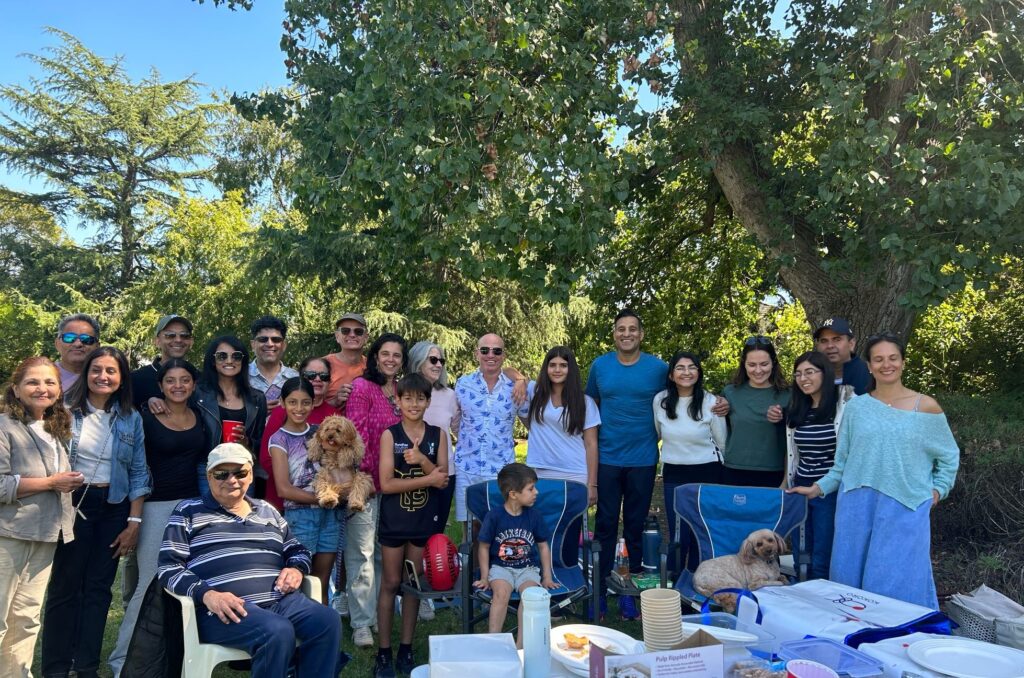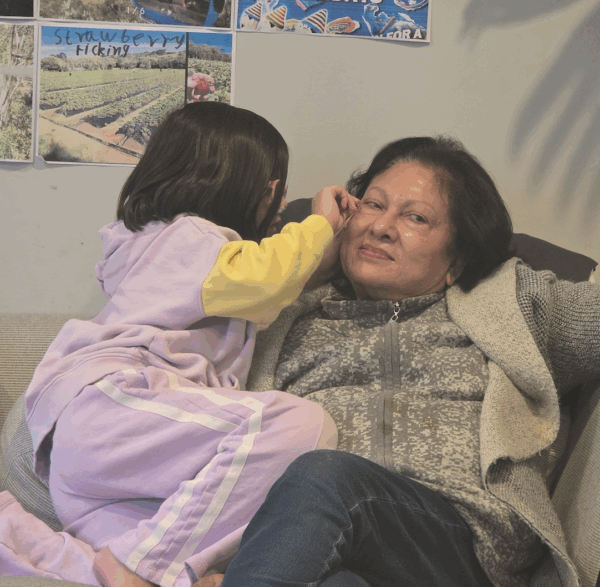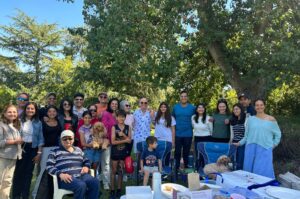Written by Piyali Somaia and Dr. Anika Kibria.

The Somaia multi-generational extended family in Melbourne (Credit: Somaia family)
The well-known civil rights term “apartheid” originated in South Africa to represent a detrimental system of segregation and discrimination leading to depravity based on race. Recently this expression has been re-purposed by Economics Professor Andrew Scott to coin a new phrase – “age apartheid” – a decline in intergenerational communities resulting in social segregation based on age. It’s as alarming as it sounds. When different age groups don’t live and socialise together it leads to a lack of intergenerational understanding, interaction and sadly, even respect. The result: extraordinary levels of isolation and loneliness globally, particularly in our older and younger generations; with negative health effects equivalent to those of smoking, physical inactivity or obesity.
How often do people of different ages come together outside family or work these days? Community living where elders (grandparents, parents, aunts and uncles) are taken care of by younger people and in return are mentored and nurtured has been common for centuries in countries such as India, Bangladesh, Malaysia and Myanmar. Not only limited to living arrangements, but villages also share resources, hold communal celebrations and look out for one another. But the decline of the village mentality has unfortunately resulted in negative attitudes towards the “old”, “young” or “middle-aged”– labelling and generalising about groups who are not only diverse in thought and experience but have much to be celebrated.
The statistics paint a telling picture. Globally, the World Health Organisation (WHO) states that a staggering 1 in 4 older people are experiencing social isolation. In Australia, research has shown that young people aged 18 to 24 are most affected by loneliness. Recent US Surgeon General Vivek Murthy has described loneliness as an epidemic on par with tobacco use and obesity. It is such an urgent public health crisis, that it has sparked the WHO commission on Social Connection (2024-2026); recognising this issue as global priority for wellbeing.
Loneliness and isolation are urgent social and health challenges that require innovative solutions to connect people across generations.
Age apartheid presents a real missed opportunity. Observing the dynamics of extended families already show us the benefits of multi-generational groups. Grandparents will attest to the fact that when they have had a smartphone or technical problem (think zoom meetings on a laptop or trying to link bank accounts on a phone app), their grandkids were able to get to the root of the issue within seconds, where they had been trying for days. Many young people will say that when they were most stressed about the pressures of school or frail friendships, a hug and a warm meal from an aunty or grandparent cheered them up.

Grandma and grandaughter love (Credit: Dr. Anika Kibria)
To counteract age apartheid, what if we begin anew with a hopeful new term such as ‘age-collaboration’? If this model of bringing together generations in a positive way was harnessed more in our collective society, imagine the benefits to the community. It would not only alleviate loneliness and social isolation, but as a by-product bring greater purpose and shared problem-solving – a recipe for better, more impactful change in the world.
The good news is there are already some great examples of age-collaboration from across the globe:
1. “Shared Village” Model in Japan
Japan, with its rapidly aging population, has initiated innovative solutions such as the “Shared Village” concept in Takasago City. These communities integrate elderly residents with young families and working professionals, creating spaces where everyone contributes and benefits. This model reduces elder loneliness and fosters active engagement, leading to improved quality of life.
2. The Cohousing Movement in Denmark
Denmark’s cohousing communities are designed with shared spaces and private residences, encouraging daily interactions among residents of all ages. In the city of Aarhus, these neighbourhoods have shown to decrease social isolation among seniors and provide children with caring mentors, fostering a vibrant, supportive environment.
3. Co-locating childcare and elder care together in UK through United for All Ages
United for All Ages is a UK-based social enterprise established in 2010. The organisation addresses loneliness, ageism, and intergenerational segregation by promoting interaction and collaboration between people of all ages. One key project is working to establish 1,000 intergenerational centres across the UK by 2030. These centres aim to co-locate services such as childcare and eldercare to promote intergenerational exchange and community.
4. The Kinship model of Australian Aboriginal communities, the oldest civilization existing on Earth
Australian Aboriginal communities exhibit a highly complex yet effective kinship model which integrates a ‘perfect’ intergenerational model. Whole tribes are divided into kinship groups which are Moieties (2 groups), Sections (4 groups) and Skin groups / subsections (eight groups). Under the kinship system, everyone is interrelated and interconnected, there are no outsiders. Everyone belongs. So, if your grandmother is from a particular clan (subsection), then ALL the women from that clan are also considered your grandmothers. If your grandfather is of another clan, then all the men from that clan will also be your grandfather. In Aboriginal kinship laws, this extends to include the entire Universe, including the animal world, plants and even non animate objects. Thus, land or country is viewed as family, and all is classified according to the ‘skin system’ or kinship laws. One can end up with tens of aunties, uncles, grandfathers, grandmothers, cousins and so on. This is known as having a ‘Big Mob’ of relatives. An extended village is an inherent part of Aboriginal culture and laws. It may be the oldest civilization, but they may hold the key for a better future for all of us.
As with all major health intersecting social issues, a top-down policy and systems change is also required to change societies norms and encourage and incentivise new ways of living. The 2024 report by End Loneliness Together x Orygen calls for A ‘Minister for Loneliness’ to lead a whole-of-government approach to the issue of isolation, including the development of a national social connection strategy. Government priorities like this are a start to tackle this challenge across the broader population.
To defeat ‘age-apartheid’, we all need to be open-minded, resourceful and proactive in our approaches. Thinking outside the box may lead to unique and effective solutions. Leaning on existing models, especially ancient cultures who have paved the way for thousands of years, may yield the most fruitful solutions. However, to adopt these ways, people and the government need to reflect on their own roles in the issue and commit to making a change for a better future for all.
About the authors:
Dr Anika completed her MBBS from Adelaide University in 2004. She then completed physician training and advanced training in geriatric medicine in Melbourne in 2017. She has worked across various Hospitals including Alfred Health, Northern Health, Austin Health and Monash Health. She has over 10 years of experience in nursing home medicine and is passionate about providing quality, compassionate care to the vulnerable.
Piyali Somaia is a global health professional, community advocate and the founder of Kahini. Kahini works towards a more equitable and healthier world through community, health and art projects. She is also a professional dancer and choreographer and believes in the power of art to create positive change in our society.



